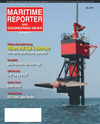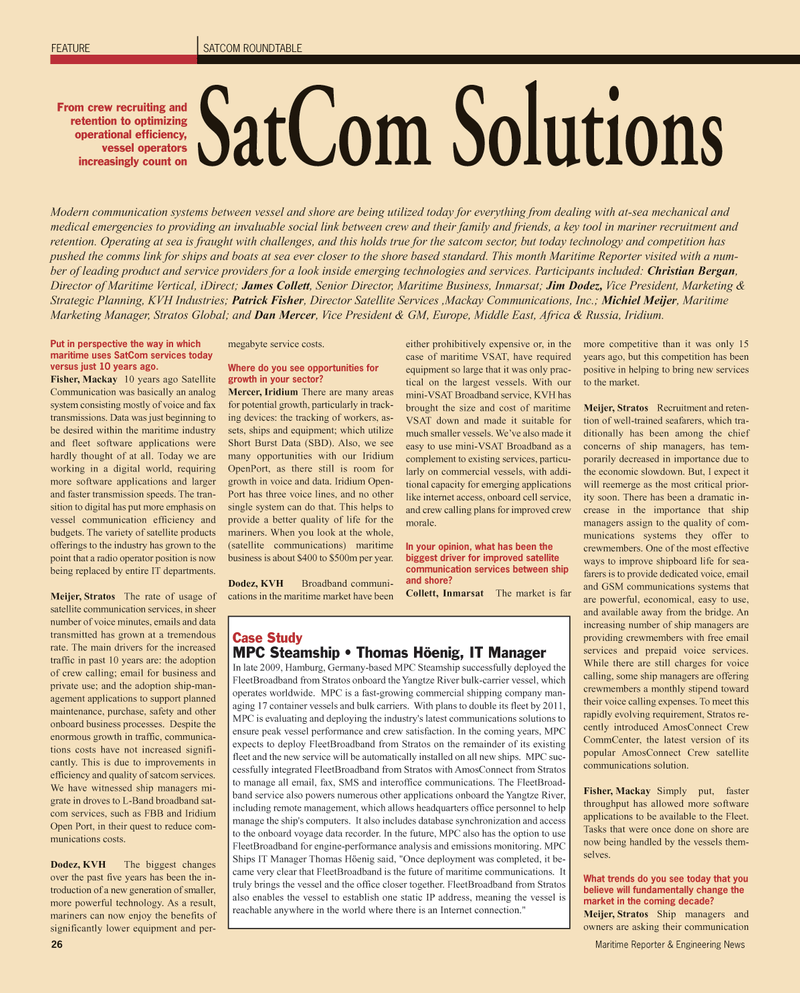
Page 26: of Maritime Reporter Magazine (July 2010)
Satellite Communication Edition
Read this page in Pdf, Flash or Html5 edition of July 2010 Maritime Reporter Magazine
26 Maritime Reporter & Engineering News
FEATURE SATCOM ROUNDTABLE
SatCom Solutions
From crew recruiting and retention to optimizing operational efficiency, vessel operators increasingly count on
Put in perspective the way in which maritime uses SatCom services today versus just 10 years ago.
Fisher, Mackay 10 years ago Satellite
Communication was basically an analog system consisting mostly of voice and fax transmissions. Data was just beginning to be desired within the maritime industry and fleet software applications were hardly thought of at all. Today we are working in a digital world, requiring more software applications and larger and faster transmission speeds. The tran- sition to digital has put more emphasis on vessel communication efficiency and budgets. The variety of satellite products offerings to the industry has grown to the point that a radio operator position is now being replaced by entire IT departments.
Meijer, Stratos The rate of usage of satellite communication services, in sheer number of voice minutes, emails and data transmitted has grown at a tremendous rate. The main drivers for the increased traffic in past 10 years are: the adoption of crew calling; email for business and private use; and the adoption ship-man- agement applications to support planned maintenance, purchase, safety and other onboard business processes. Despite the enormous growth in traffic, communica- tions costs have not increased signifi- cantly. This is due to improvements in efficiency and quality of satcom services.
We have witnessed ship managers mi- grate in droves to L-Band broadband sat- com services, such as FBB and Iridium
Open Port, in their quest to reduce com- munications costs.
Dodez, KVH The biggest changes over the past five years has been the in- troduction of a new generation of smaller, more powerful technology. As a result, mariners can now enjoy the benefits of significantly lower equipment and per- megabyte service costs.
Where do you see opportunities for growth in your sector?
Mercer, Iridium There are many areas for potential growth, particularly in track- ing devices: the tracking of workers, as- sets, ships and equipment; which utilize
Short Burst Data (SBD). Also, we see many opportunities with our Iridium
OpenPort, as there still is room for growth in voice and data. Iridium Open-
Port has three voice lines, and no other single system can do that. This helps to provide a better quality of life for the mariners. When you look at the whole, (satellite communications) maritime business is about $400 to $500m per year.
Dodez, KVH Broadband communi- cations in the maritime market have been either prohibitively expensive or, in the case of maritime VSAT, have required equipment so large that it was only prac- tical on the largest vessels. With our mini-VSAT Broadband service, KVH has brought the size and cost of maritime
VSAT down and made it suitable for much smaller vessels. We’ve also made it easy to use mini-VSAT Broadband as a complement to existing services, particu- larly on commercial vessels, with addi- tional capacity for emerging applications like internet access, onboard cell service, and crew calling plans for improved crew morale.
In your opinion, what has been the biggest driver for improved satellite communication services between ship and shore?
Collett, Inmarsat The market is far more competitive than it was only 15 years ago, but this competition has been positive in helping to bring new services to the market.
Meijer, Stratos Recruitment and reten- tion of well-trained seafarers, which tra- ditionally has been among the chief concerns of ship managers, has tem- porarily decreased in importance due to the economic slowdown. But, I expect it will reemerge as the most critical prior- ity soon. There has been a dramatic in- crease in the importance that ship managers assign to the quality of com- munications systems they offer to crewmembers. One of the most effective ways to improve shipboard life for sea- farers is to provide dedicated voice, email and GSM communications systems that are powerful, economical, easy to use, and available away from the bridge. An increasing number of ship managers are providing crewmembers with free email services and prepaid voice services.
While there are still charges for voice calling, some ship managers are offering crewmembers a monthly stipend toward their voice calling expenses. To meet this rapidly evolving requirement, Stratos re- cently introduced AmosConnect Crew
CommCenter, the latest version of its popular AmosConnect Crew satellite communications solution.
Fisher, Mackay Simply put, faster throughput has allowed more software applications to be available to the Fleet.
Tasks that were once done on shore are now being handled by the vessels them- selves.
What trends do you see today that you believe will fundamentally change the market in the coming decade?
Meijer, Stratos Ship managers and owners are asking their communication
Modern communication systems between vessel and shore are being utilized today for everything from dealing with at-sea mechanical and medical emergencies to providing an invaluable social link between crew and their family and friends, a key tool in mariner recruitment and retention. Operating at sea is fraught with challenges, and this holds true for the satcom sector, but today technology and competition has pushed the comms link for ships and boats at sea ever closer to the shore based standard. This month Maritime Reporter visited with a num- ber of leading product and service providers for a look inside emerging technologies and services. Participants included: Christian Bergan,
Director of Maritime Vertical, iDirect; James Collett, Senior Director, Maritime Business, Inmarsat; Jim Dodez, Vice President, Marketing &
Strategic Planning, KVH Industries; Patrick Fisher, Director Satellite Services ,Mackay Communications, Inc.; Michiel Meijer, Maritime
Marketing Manager, Stratos Global; and Dan Mercer, Vice President & GM, Europe, Middle East, Africa & Russia, Iridium.
Case Study
MPC Steamship • Thomas Höenig, IT Manager
In late 2009, Hamburg, Germany-based MPC Steamship successfully deployed the
FleetBroadband from Stratos onboard the Yangtze River bulk-carrier vessel, which operates worldwide. MPC is a fast-growing commercial shipping company man- aging 17 container vessels and bulk carriers. With plans to double its fleet by 2011,
MPC is evaluating and deploying the industry's latest communications solutions to ensure peak vessel performance and crew satisfaction. In the coming years, MPC expects to deploy FleetBroadband from Stratos on the remainder of its existing fleet and the new service will be automatically installed on all new ships. MPC suc- cessfully integrated FleetBroadband from Stratos with AmosConnect from Stratos to manage all email, fax, SMS and interoffice communications. The FleetBroad- band service also powers numerous other applications onboard the Yangtze River, including remote management, which allows headquarters office personnel to help manage the ship's computers. It also includes database synchronization and access to the onboard voyage data recorder. In the future, MPC also has the option to use
FleetBroadband for engine-performance analysis and emissions monitoring. MPC
Ships IT Manager Thomas Höenig said, "Once deployment was completed, it be- came very clear that FleetBroadband is the future of maritime communications. It truly brings the vessel and the office closer together. FleetBroadband from Stratos also enables the vessel to establish one static IP address, meaning the vessel is reachable anywhere in the world where there is an Internet connection."

 25
25

 27
27
